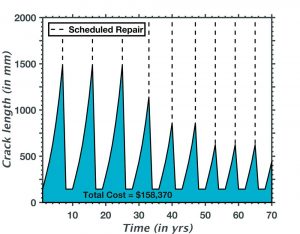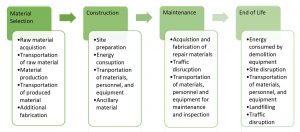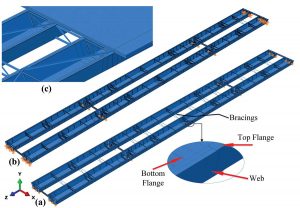Life-cycle assessment (LCA) is a quantitative means for assessing the environmental impact of an object. In structural engineering, the object of interest may be a building, bridge, or other structure. In order to provide a complete picture, the environmental impacts from the entire life-cycle of the object is considered: from the acquisition of the raw materials needed to form the members, through the energy and ancillary materials involved in the processing and transportation of these materials and members, excavation required during construction, future maintenance such as redecking or painting, up to the end use or disposal of the members. Once the inventory of all of these items is completed, the associated environmental impacts on climate, air quality, water quality, human health, and resource depletion can be characterized using standardized methods. For example, the global warming potential of a project can be expressed in terms of the equivalent mass of CO2. Such an analysis can be completed using various methods and software to reveal the potential for minimizing environmental impacts on a project, for comparing alternative design concepts, and for obtaining credits in sustainability guidelines such as Envision and LEED.
On the other hand, life-cycle cost analysis (LCCA) is a well-known concept for evaluating the economics of a structure, typically used to evaluate whether a particular investment or initial cost has a long-term economic advantage for reasons such as reduced maintenance or longer useful life. While LCCA and LCA originated and are typically applied with very different goals in mind – determining the most cost-effective option versus determining the most sustainable option – the two concepts are not unrelated. Contrary to a common misconception, the most sustainable option is also often the most cost-efficient option when considering the full life cycle. For example, the use of fly ash in place of ordinary portland cement results in significant reductions in CO2 and hence global warming potential as well as cost savings and improved durability in typical applications.
The life-cycle of a steel bridge can be considered in four phases: design (resulting in choices of materials and their quantities), construction, in-service (where inspection is required and maintenance is typically needed), and end-of-life (where the materials must be disposed of or repurposed). The most substantial environmental impacts come from the acquisition and fabrication of the materials based on the design of the structure: information is available in other publications to assist designers with minimizing this impact. The environmental impacts from the construction and in-service phases can also be minimized based on thoughtful actions from structural engineers.
LCA Data from Construction Alternatives
What is considered in an LCA of steel bridge construction? An LCA of the construction of a structure accounts for the environmental impacts associated with its erection. Figure 1 lists the impacts directly associated with construction for a typical project: site preparation (e.g., excavation or dewatering); energy (e.g., diesel fuel) consumed by construction equipment; transportation of materials, personnel, and equipment to the construction site; and the ancillary material (e.g., formwork) used in construction. However, the construction method often affects the design of the structure. For example, whether or not scaffolding will be used, the lifting sequences of curved steel girders, and options of balanced cantilevering or launching of segmental concrete bridges affect the material quantities used in the structural design. Furthermore, options for accelerated bridge construction (ABC) techniques, such as prefabricated versus cast-in-place deck elements and slide-in construction, also affect environmental impacts related to both construction and design. Thus, the LCA is not exclusive to the environmental impacts occurring during construction, but also includes the environmental impacts from the material quantities used in the design of the structure.
How can sustainability impacts from construction variables be assessed? With a cognizant perspective of the basic reduce-reuse-recycle concept, many qualitative inferences can be made. For example, the essential principle of ABC is to reduce construction time, from which it logically follows that diesel fuel consumed by construction vehicles and traffic impacts (and the associated natural resource depletion and air pollution) would also be reduced. However, in some cases, this could be offset by additional site clearing or preparation. Other logical ways to reduce the environmental impact of construction choices include reusing formwork and diverting construction waste from landfills into functional purposes.
How can sustainability impacts from construction variables be quantitatively assessed? LCA provides the framework for a quantitative assessment to more rigorously evaluate the relative impacts of the different components of the construction process and compare construction (or other) alternatives; recent studies have carried out such work. One such example is the work of Dequidt (2012), who quantified the global warming potential (GWP) associated with bridge construction for a sample project. This work showed that approximately 80% of the GWP from the construction phase was associated with transportation to the site, 20% was associated with diesel fuel consumed by construction equipment, and the remaining factors were negligible. In a case study comparing five different construction alternatives, diesel fuel consumption was again found to be a significant variable. In this case, varying by as much as 65%, depending on how much work was done onsite versus prefabricated. Furthermore, the results of three different LCA studies can be compared to provide information regarding conventional construction versus launching. This comparison shows that for bridges with similar lengths (1000 ft.), launching reduced the GWP by 25% and the acidification potential by 64%, even after considering the design modifications needed to resist the unique stresses resulting from the launching process.
Optimizing In-Service Performance
How can LCCA impact the scheduling of inspection and repair of bridges to extend the life-span of bridges and save taxpayer’s money? In the United States, 11% of the bridges are classified as fracture critical, 83% of which are two girder steel bridges. Steel twin-tub girder bridges, similar to that shown in Figure 2, are a common example of a two-girder steel bridge. The cost implications of the bi-annual inspection mandate are enormous and impose financial strain. This problem is further aggravated by the fact that most bridges in the United States were built around the 1960s and many of them have shown significant signs of aging and deterioration. Demolition and replacement of these bridges is an expensive alternative. The development of these cost-effective strategies requires the formulation of LCCA models, which need to include both epistemic and aleatory uncertainties associated with the specific bridge in question. Several researchers have developed comprehensive probabilistic LCCA frameworks for optimal maintenance budget allocation regarding deteriorating structures. These studies have quite effectively highlighted the importance and need for efficient LCCA strategies to establish well-balanced intervention schedules that consider various economic and safety requirements while taking into account uncertainties associated with the time-dependent structural performance. Implementation of these strategies is likely to result in a more extended period between inspections for most bridges. More quantitative-based inspection and maintenance intervals may also reduce the environmental impacts of these actions, for example by reducing the emissions associated with inspections and reducing the need for future materials for more extensive rehabilitations or bridge replacements.
What is considered in the LCCA of bridges? Assessment of life-cycle cost requires sufficient understanding of all factors involved in maintaining and prolonging the life of the structure. This may include, but is not limited to, inspection, repair, and maintenance. Depending on the nature of the method adopted for each activity, the life-cycle cost could vary significantly. For example, the inspection cost is heavily dependent on the method used (e.g., ultrasonic versus visual inspection). Since the life-cycle cost calculated is an expected value, the inspection cost for a specific inspection type will have to be multiplied by the probability of detection, which could have a significant impact on the overall cost. There exist several types of inspection methods, each with a distinct accuracy. Depending on the crack size and inspection type, sometimes critical cracks would not be detected during the inspection phase. In addition to the expected direct cost associated with the inspection method, indirect cost should be included in the LCCA. For inspection, the indirect cost will mainly depend on the time taken by the specific inspection method and the closure cost per day, which is independent of the method type. In case of repair costs, both direct and indirect components should be considered and are typically related to the crack length, which in turn vary with time probabilistically. The direct repair cost is proportional to the crack length and could be defined as the cost per unit length of the crack. The indirect cost, on the other hand, could be defined as the product of closure cost per day, crack length, and the amount of time taken to repair a crack of a specific length. This general formulation has been established and applied to studies on various structures.

Figure 3. a) Convergence of the stress field around the crack; b) Finite element mesh of the bridge; c) Zoom in on the cracked region.
What is expected from LCCA results? The intervals at which these inspections and maintenance activities should be specified require careful deliberation to minimize life-cycle cost of structures while ensuring structural safety. Therefore, optimization is required where the life-cycle cost information, along with the probabilistic curves of fatigue crack growth, can be used to calculate optimal inspection/repair routines. The probabilistic curves of fatigue crack growth can be developed using simplified analytical fatigue growth models or using comprehensive finite element models similar to that shown in Figure 3. The advantage of using comprehensive finite element modeling is the minimization of uncertainties associated with modeling the structure or the crack. The optimization is performed to obtain an optimal inspection-repair schedule, such that the service life can be extended to a desired target life (e.g., 70 yrs). Figure 4 shows an example of a schedule pattern for inspection and repair.

Figure 4. Schedule pattern for inspection and repair of the crack at the location of interest for minimum life cycle cost.
Conclusion
Both LCA and LCCA represent optimization problems. In the former, the goal is to minimize environmental impact; in the latter, the goal is to minimize cost. The above discussion reveals that minimizing certain metrics can have a significant influence on both of these goals. Based on the data presently available, the most significant of these appears to be time on site. From an environmental perspective, reducing the time on site translates into reduced diesel fuel emissions from construction equipment, reduced emissions from personal transportation of workers, reduced emissions from traffic delays, and the associated reduction in fossil fuel consumption. For the same reasons, reduced time on site can also translate into reduced cost for both public agencies and the traveling public. Other strategies for minimizing the environmental impact of steel bridge construction, supported by LCA data, include the selection of local materials and launching longer span bridges. During the service life of a bridge, most of the available work focuses on LCCA, which highlights that understanding problematic locations in bridges is key to minimizing direct costs associated with inspection and indirect costs associated with bridge closures. This includes, for example, identification of fatigue-prone details before implementation of the inspection program. Furthermore, one maintenance strategy supported by LCA is the design of selective retrofits to improve natural hazard resistance.▪
References
Connor, R., Dexter, R., & Mahmoud, H. (2005). NCHRP Synthesis 354: Inspection and Management of Bridges with Fracture-Critical Details. Transportation Research Board.
Dequidt, T. (2012). Life cycle assessment of a Norwegian bridge. Master’s thesis, Department of Civil and Transport Engineering, Norwegian University of Science and Technology.
Du, G., Safi, M., Pettersson, L., & Karoumi, R. (2014). Life cycle assessment as a decision support tool for bridge procurement: Environmental impact comparison among five bridge designs. The International Journal of Life Cycle Assessment, 19(12), 1948-1964.
Estes, A. C. & Frangopol, D. M. (1999). Repair optimization of highway bridges using system reliability approach, Journal of Structural Engineering, 125(7), 766-775.
Faber, M. H. & Sorensen, J. D. (2002). Indicators for inspection and maintenance planning of concrete structures. Journal of Structural Safety, 24, 377-396.
Hammervold, J., Brattebø, H., & Reenaas, M. (2013). Environmental life cycle assessment of bridges. Journal of Bridge Engineering, 18(2), 153-161.
Kong, J. S. & Frangopol, D. M. (2003). Life-cycle reliability-based maintenance cost optimization of deteriorating structures with emphasis on bridges, Journal of Structural Engineering, 129(6), 818-828.
Mahmoud, H. and Chulahwat, A., and Riveros, G. (2017) Fatigue and Fracture Lifecycle Cost Assessment of a Miter Gate with Multiple Cracks, Engineering Failure Analysis, doi.org/10.1016/j.engfailanal.2017.09.008.
Mahmoud, H., Chulahwat, A., and Irfaee, M. “Inspection Intervals of Fracture-Critical Steel Bridges Based on Fatigue and Fracture Life-cycle Cost Assessment.” World Steel Bridge Symposium World Steel Bridge Symposium, Baltimore, MD, April 2018.
McConnell, J., Stone, E. & Yost, J. (2017). “Optimizing Concrete for More Sustainable Bridges,” STRUCTURE magazine.
Padgett, J. & Tapia, C. (2013). “Sustainability of Natural Hazard Risk Mitigation: Life Cycle Analysis of Environmental Indicators for Bridge Infrastructure,” Journal of Infrastructure Systems, 19, 395-408,
Rantala, T. (2010). Life cycle analysis of Mälkiä canal bridge. Report, Finnish Transport Agency.
Stewart, M. G., Estes, A. C. & Frangopol, D. M. (2004). Bridge deck replacement for minimum expected cost under multiple reliability constraints. Journal of Structural Engineering, 130(9), 1414-1419.
Webster, M. (ed.). (2017). “Structural Materials and Global Climate: A Primer on Carbon Emissions for Structural Engineers,” ASCE Press, Washington, D.C.


